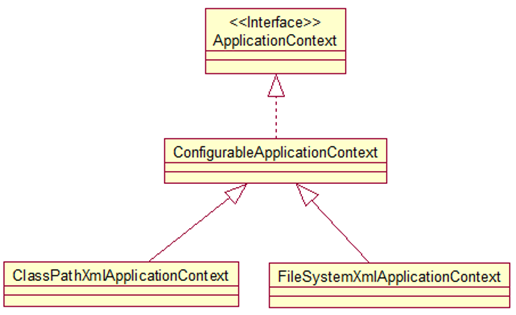Spring总结_04_容器和bean
一.概念理解
1.容器
IoC容器负责容纳并管理bean,在Spring中,BeanFactory是IoC容器的核心接口。 它的职责包括:实例化、定位、配置应用程序中的对象及建立这些对象间的依赖。
Spring提供两种IoC容器的实现:
(1)BeanFactory :org.springframework.beans.factory.BeanFactory 是Spring IoC容器的基本实现,是Spring IoC容器实际代表者
BeanFactory是Spring框架的基础设施,面向Spring本身
(2)ApplicationContext:提供了更多的高级特性,是BeanFactory的子类。
ApplicationContext面向开发者。几乎所有的场合都直接使用ApplicationContext而非底层的BeanFactory。

ApplicationContext 的主要实现类:
ClassPathXmlApplicationContext:从 类路径下加载配置文件
FileSystemXmlApplicationContext: 从文件系统中加载配置文件
ConfigurableApplicationContext 扩展于 ApplicationContext,新增加两个主要方法:refresh() 和 close(), 让 ApplicationContext 具有启动、刷新和关闭上下文的能力
2.bean
在Spring中,那些组成你应用程序的主体(backbone)及由Spring IoC容器所管理的对象,被称之为bean。 简单地讲,bean就是由Spring容器初始化、装配及管理的对象
bean的定义由BeanDefinition 对象来表示,该定义将包含以下信息:
- 全限定类名: 这通常就是已定义bean的实际实现类。
- bean行为的定义: 这些定义将决定bean在容器中的行为(作用域、生命周期回调等等)
- 对其他bean的引用: 这些引用bean也可以称之为协作bean(collaborators) 或依赖bean(dependencies).
- 创建bean实例时的其他配置设置。比如使用bean来定义连接池,可以通过属性或者构 造参数指定连接数,以及连接池大小限制等。
上述内容直接被翻译为每个bean定义包含的一组properties。
二.bean的配置
1. 简单实例
java bean: HelloWorld.java
package com.ray.spring;
public class HelloWorld {
private String name;
public void setName(String name){
this.name=name;
}
public void hello(){
System.out.println("hello:"+name);
}
}
配置文件:applicationContext.xml
<?xml version="1.0" encoding="UTF-8"?>
<beans xmlns="http://www.springframework.org/schema/beans"
xmlns:xsi="http://www.w3.org/2001/XMLSchema-instance"
xmlns:util="http://www.springframework.org/schema/util"
xmlns:p="http://www.springframework.org/schema/p"
xsi:schemaLocation="http://www.springframework.org/schema/beans http://www.springframework.org/schema/beans/spring-beans.xsd
http://www.springframework.org/schema/util http://www.springframework.org/schema/util/spring-util-4.0.xsd">
<!-- 配置一个 bean
class:bean的全类名,通过反射的方式在IoC容器中穿件Bean.所以要求Bean中必须有无参构造器
id:标识容器中的bean,id唯一。若有多个id,则第一个是标识符,其他为别名。
-->
<bean id="helloWorld" class="com.ray.spring.HelloWorld">
<!-- 为属性赋值
通过属性注入: 通过 setter 方法注入属性值
-->
<property name="name" value="Tom"></property>
</bean>
</beans>
bean的实例化:Main.java
package com.ray.spring;
import org.springframework.context.ApplicationContext;
import org.springframework.context.support.ClassPathXmlApplicationContext;
public class Main {
public static void main(String[] args) {
//1. 创建 Spring 的 IOC 容器,ApplicationContext代表IoC容器
ApplicationContext ctx = new ClassPathXmlApplicationContext("applicationContext.xml");
/*2. 从 IOC 容器中获取 bean 的实例
2.1利用id定位到IoC容器中的bean
*/
HelloWorld helloWorld = (HelloWorld) ctx.getBean("helloWorld");
//2.2利用类型返回IoC容器中的bean,但要求IoC容器中必须只有一个该类型的bean
//HelloWorld helloWorld = (HelloWorld) ctx.getBean("helloWorld");
//3. 使用 bean
helloWorld.hello();
}
}
2. bean的依赖注入
Spring 支持 3 种依赖注入的方式:属性注入、构造器注入、工厂方法注入(很少使用,不推荐)
2.1 属性注入
属性注入即通过 setter 方法注入Bean 的属性值或依赖的对象
属性注入是实际应用中最常用的注入方式。
<?xml version="1.0" encoding="UTF-8"?>
<beans xmlns="http://www.springframework.org/schema/beans"
xmlns:xsi="http://www.w3.org/2001/XMLSchema-instance"
xmlns:util="http://www.springframework.org/schema/util"
xmlns:p="http://www.springframework.org/schema/p"
xsi:schemaLocation="http://www.springframework.org/schema/beans http://www.springframework.org/schema/beans/spring-beans.xsd
http://www.springframework.org/schema/util http://www.springframework.org/schema/util/spring-util-4.0.xsd">
<bean id="helloWorld" class="com.ray.spring.HelloWorld">
<!-- 通过属性注入: 通过 setter 方法注入属性值
<property>节点:设置属性
name :指定 Bean 的属性名称
value 或 <value> 子节点:指定属性值
-->
<property name="name" value="Tom"></property>
</bean>
</beans>
2.2 构造器注入
构造器注入即 通过配置构造器参数,来注入Bean 的属性值或依赖的对象,它保证了 Bean 实例在实例化后就可以使用。
Java bean: Car.java
package com.ray.spring;
public class Car {
private String brand;
private String corp;
private double price;
private int maxSpeed;
public Car(String brand, String corp, double price) {
super();
this.brand = brand;
this.corp = corp;
this.price = price;
}
public Car(String brand, String corp, int maxSpeed) {
super();
this.brand = brand;
this.corp = corp;
this.maxSpeed = maxSpeed;
}
@Override
public String toString() {
return "Car [brand=" + brand + ", corp=" + corp + ", price=" + price
+ ", maxSpeed=" + maxSpeed + "]";
}
}
配置文件: applicationContext.xml
<?xml version="1.0" encoding="UTF-8"?>
<beans xmlns="http://www.springframework.org/schema/beans"
xmlns:xsi="http://www.w3.org/2001/XMLSchema-instance"
xmlns:util="http://www.springframework.org/schema/util"
xmlns:p="http://www.springframework.org/schema/p"
xsi:schemaLocation="http://www.springframework.org/schema/beans http://www.springframework.org/schema/beans/spring-beans.xsd
http://www.springframework.org/schema/util http://www.springframework.org/schema/util/spring-util-4.0.xsd">
<!-- 通过构造器注入属性值
1.按参数顺序注入-->
<bean id="car1" class="com.ray.spring.Car">
<!-- 都要求: 在 Bean 中必须有对应的构造器. -->
<constructor-arg value="Audi"></constructor-arg>
<constructor-arg value="ShangHai"></constructor-arg>
<constructor-arg value="300000"></constructor-arg>
</bean>
<!--2.通过参数索引注入-->
<bean id="car2" class="com.ray.spring.Car">
<constructor-arg value="Audi" index="0"></constructor-arg>
<constructor-arg value="ShangHai" index="1"></constructor-arg>
<constructor-arg value="300000" type="double"></constructor-arg>
</bean>
<!--3.通过参数类型注入-->
<bean id="car3" class="com.ray.spring.Car">
<constructor-arg value="Audi" type="java.lang.String"></constructor-arg>
<constructor-arg value="ShangHai" type="java.lang.String"></constructor-arg>
<constructor-arg value="300000" type="int"></constructor-arg>
</bean>
</beans>
bean的实例化:
package com.ray.spring;
import org.springframework.context.ApplicationContext;
import org.springframework.context.support.ClassPathXmlApplicationContext;
public class Main {
public static void main(String[] args) {
//1. 创建 Spring 的 IOC 容器,ApplicationContext代表IoC容器
ApplicationContext ctx = new ClassPathXmlApplicationContext("applicationContext.xml");
//2. 从 IOC 容器中获取 bean 的实例
Car car=(Car)ctx.getBean("car1");
System.out.println(car);
car=(Car)ctx.getBean("car2");
System.out.println(car);
car=(Car)ctx.getBean("car3");
System.out.println(car);
}
}
Spring总结_04_容器和bean的更多相关文章
- Spring学习-- IOC 容器中 bean 的生命周期
Spring IOC 容器可以管理 bean 的生命周期 , Spring 允许在 bean 声明周期的特定点执行定制的任务. Spring IOC 容器对 bean 的生命周期进行管理的过程: 通过 ...
- Spring IOC 一——容器装配Bean的简单使用
下文:SpringIOC 二-- 容器 和 Bean的深入理解 写在前面 这篇文章去年写的,缘起于去年某段时间被领导临时"抓壮丁"般的叫过去做java开发,然后在网上找了一个 Sp ...
- Spring重点—— IOC 容器中 Bean 的生命周期
一.理解 Bean 的生命周期,对学习 Spring 的整个运行流程有极大的帮助. 二.在 IOC 容器中,Bean 的生命周期由 Spring IOC 容器进行管理. 三.在没有添加后置处理器的情况 ...
- Spring为IOC容器注入Bean的五种方式
一 @Import导入组件,id默认是组件的全类名 //类中组件统一设置.满足当前条件,这个类中配置的所有bean注册才能生效: @Conditional({WindowsCondition.clas ...
- Spring技术内幕_IOC容器载入Bean定义资源文件
转自:http://blog.csdn.net/chjttony/article/details/6259723 1.当spring的IoC容器将Bean定义的资源文件封装为Spring的Resour ...
- SpringIOC 二—— 容器 和 Bean的深入理解
上文:Spring IOC 一--容器装配Bean的简单使用 上篇文章介绍了 Spring IOC 中最重要的两个概念--容器和Bean,以及如何使用 Spring 容器装配Bean.本文接着记录 S ...
- spring容器对bean生命周期的管理三中方式
spring容器对bean的生命周期管理主要在两个时间点:bean的初始化完成(包括属性值被完全注入),bean的销毁(程序结束,或者引用结束)方式一:使用springXML配置中的init-meth ...
- [原创]java WEB学习笔记101:Spring学习---Spring Bean配置:IOC容器中bean的声明周期,Bean 后置处理器
本博客的目的:①总结自己的学习过程,相当于学习笔记 ②将自己的经验分享给大家,相互学习,互相交流,不可商用 内容难免出现问题,欢迎指正,交流,探讨,可以留言,也可以通过以下方式联系. 本人互联网技术爱 ...
- Spring基础——在 IOC 容器中 Bean 之间的关系
一.在 Spring IOC 容器中 Bean 之间存在继承和依赖关系. 需要注意的是,这个继承和依赖指的是 bean 的配置之间的关系,而不是指实际意义上类与类之间的继承与依赖,它们不是一个概念. ...
随机推荐
- Java 的String类
String类 1.String对象的初始化 由于String对象特别常用,所以在对String对象进行初始化时,Java提供了一种简化的特殊语法,格式如下: String s = “abc”; s ...
- Libcurl细说
libcurl教程 原文地址:http://curl.haxx.se/libcurl/c/libcurl-tutorial.html 译者:JGood(http://blog.csdn.net/J ...
- Canvas 颜色反转
ImageData中的元素反转颜色 255-data[i,i+1,i+2] <!DOCTYPE html> <html lang="en"> <hea ...
- Bootstrap入门(四)表格
Bootstrap入门(四)表格 <table>标签 首先,引入bootstrap的css文件,然后表格内容放在一个class为table的<table>标签中(class=& ...
- 3D游戏开发之在UE4中创建非玩家角色(NPC)
接着上节我们继续学习,现在我们来创建一些NPC(non-playable characters,非玩家角色).在这个游戏中,当我们靠近NPC时,它们会做出相应的反应. 一 创建C++类 1) 在UE编 ...
- canvas小程序-快跑程序员
canvas不用说html5带来的好东西,游戏什么的,么么哒 记得有一天玩手机游戏,就是一个跳跃过柱子那种,其实元素很简单啊,app能开发,借助html5 canvas也可以啊, 于是就开始了. -- ...
- 使用Typescript来写javascript
使用Typescript来写javascript 前几天尝试使用haxejs来写javascript,以获得静态类型带来的益处.虽然成功了,但很快发现将它与angularjs一起使用,有一些不太顺畅的 ...
- Bezier(贝塞尔)曲线简介
在计算机图形学中,Bezier曲线被广泛用于对平滑的曲线进行建模,对其有适当的了解是必要的.一条Bezier曲线由一系列控制点定义,称为曲线的阶数,由此可知,使用两个控制点()可以定义一条一阶Bezi ...
- 穷举 迭代 while
for循环拥有两类: 穷举: 把所有可能的情况都走一遍,使用if条件筛选出来满足条件的情况. 例:1.单位给发了一张150元购物卡,拿着到超市买三类洗化用品.洗发水15元,香皂2元,牙刷5元.求刚好花 ...
- 访问量分类统计(QQ,微信,微博,网页,网站APP,其他)
刚准备敲键盘,突然想起今天已经星期五了,有点小兴奋,一周又这么愉快的结束,又可以休息了,等等..我好像是来写Java博客的,怎么变成了写日记,好吧,言归正传. 不知道大家有没有遇到过这样的需求:统计一 ...
